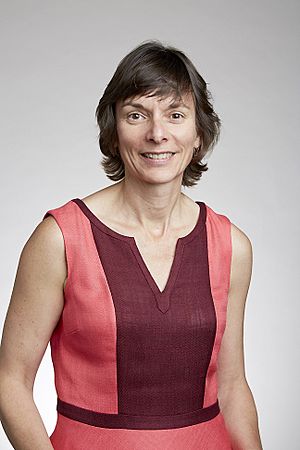Nicola Spaldin facts for kids
Quick facts for kids
Nicola Spaldin
|
|
|---|---|

Nicola Spaldin at the Royal Society admissions day in London, July 2017
|
|
| Born | 1969 (age 55–56) Sunderland, UK
|
| Alma mater | University of Cambridge (BA) University of California, Berkeley (PhD) |
| Awards | James C. McGroddy Prize for New Materials (2010) Rössler Prize (2012) Körber European Science Prize (2015) L'Oreal-UNESCO For Women in Science Award (2017) Swiss Science Prize Marcel Benoist (2019) IUPAP Magnetism Prize and Néel Medal (2021) Europhysics Prize (2022) Hamburg Prize for Theoretical Physics (2022) Gothenburg Physics Centre Lise Meitner Award (2023) CNRS Fellow-Ambassadeur (2024) Doctor of Science (honoris causa), Queens University, Belfast (2024) |
| Scientific career | |
| Fields |
|
| Institutions | ETH Zurich University of California, Santa Barbara Yale University |
| Thesis | Calculating the electronic properties of semiconductor nanostructures (1996) |
Nicola Ann Spaldin (born in 1969) is a brilliant professor of materials science at ETH Zurich in Switzerland. She is famous for her amazing work on special materials called multiferroics. She is also a Fellow of the Royal Society, which is a very important science group.
Contents
Early Life and Schooling
Nicola Spaldin grew up in Sunderland, Tyne and Wear, England. She went to the University of Cambridge and earned a Bachelor of Arts degree in natural sciences in 1991. Later, she moved to the United States. In 1996, she earned her PhD in chemistry from the University of California, Berkeley.
Discovering Multiferroics
After finishing her PhD, Professor Spaldin did research at Yale University from 1996 to 1997. During this time, she became interested in a special type of material. These materials are called multiferroics. They are unique because they are both magnetic and ferroelectric. This means they can be controlled by both magnetic and electric fields.
Explaining Multiferroic Materials
In 2000, Professor Spaldin published an important article. This article helped explain why there were so few known multiferroic materials. Her work laid the groundwork for understanding these fascinating substances.
Breakthroughs with Bismuth Ferrite
In 2003, Professor Spaldin was part of a team that made a big discovery. They showed that a material called bismuth ferrite (BiFeO3) had multiferroic properties. This was a huge step forward!
Over the next few years, she helped with many new discoveries in this field. For example, her team showed how to control the magnetism in BiFeO3 using an electric field. This was even highlighted by Science magazine in 2007. They also found new ways that materials could be multiferroic.
Research at ETH Zurich
In 2010, Professor Spaldin moved to ETH Zurich in Switzerland. There, her research took new and exciting turns.
Exploring Magnetic Multipoles
One new area of her research is about "magnetic multipoles." This is a more advanced way to understand magnetism. It helps explain how magnetism works on the surfaces of certain materials. It also helps describe things like "altermagnetism" and "magnetic skyrmions."
Understanding Dynamical Multiferroicity
Another direction is "Dynamical Multiferroicity." This led to interest in "chiral phonons." These are tiny vibrations in materials that can create magnetic moments.
Connecting Multiferroics to Fundamental Physics
Professor Spaldin also found surprising uses for multiferroics in other areas of physics. She designed a new multiferroic material to help search for the electric dipole moment of the electron. This is a very tiny property of electrons that scientists are trying to find. She also found a multiferroic that creates something like "cosmic strings" in its structure. These projects even led to her current interest in searching for dark matter.
You can find a list of her published research on Google scholar.
Awards and Recognitions
Professor Spaldin has received many important awards for her work.
- In 2010, she won the James C. McGroddy Prize for New Materials.
- She received the Rössler Prize in 2012.
- In 2015, she won the Körber European Science Prize for her work on multiferroic materials.
- She was also honored with the L'Oréal-UNESCO Awards for Women in Science in 2017.
- In 2019, she won the Swiss Science Prize Marcel Benoist.
- She received the IUPAP Magnetism Award and Néel Medal in 2021.
- In 2022, she won the Europhysics Prize and the Hamburg Prize for Theoretical Physics.
- Most recently, in 2023, she won the Gothenburg Lise Meitner Award.
Professor Spaldin is also a member of many important scientific groups. She is a Fellow of the American Physical Society, the Materials Research Society, and the Royal Society. She is also a member of the French Academy of Sciences and the German National Academy of Sciences.
Teaching and Service
Professor Spaldin is not only a great researcher but also an excellent teacher. She has won the ETH Golden Owl for Teaching Excellence twice. She also received the ETH Award for Best Teaching. Some of her lectures are available online for students to watch. She helped update the Bachelor of Science curriculum in her department. She also wrote a textbook about magnetic materials.
She is also a member of the ERC Scientific Council. This group helps decide which science projects get funding in Europe. She is also a founding Lead Editor for a science journal called Physical Review Research.

